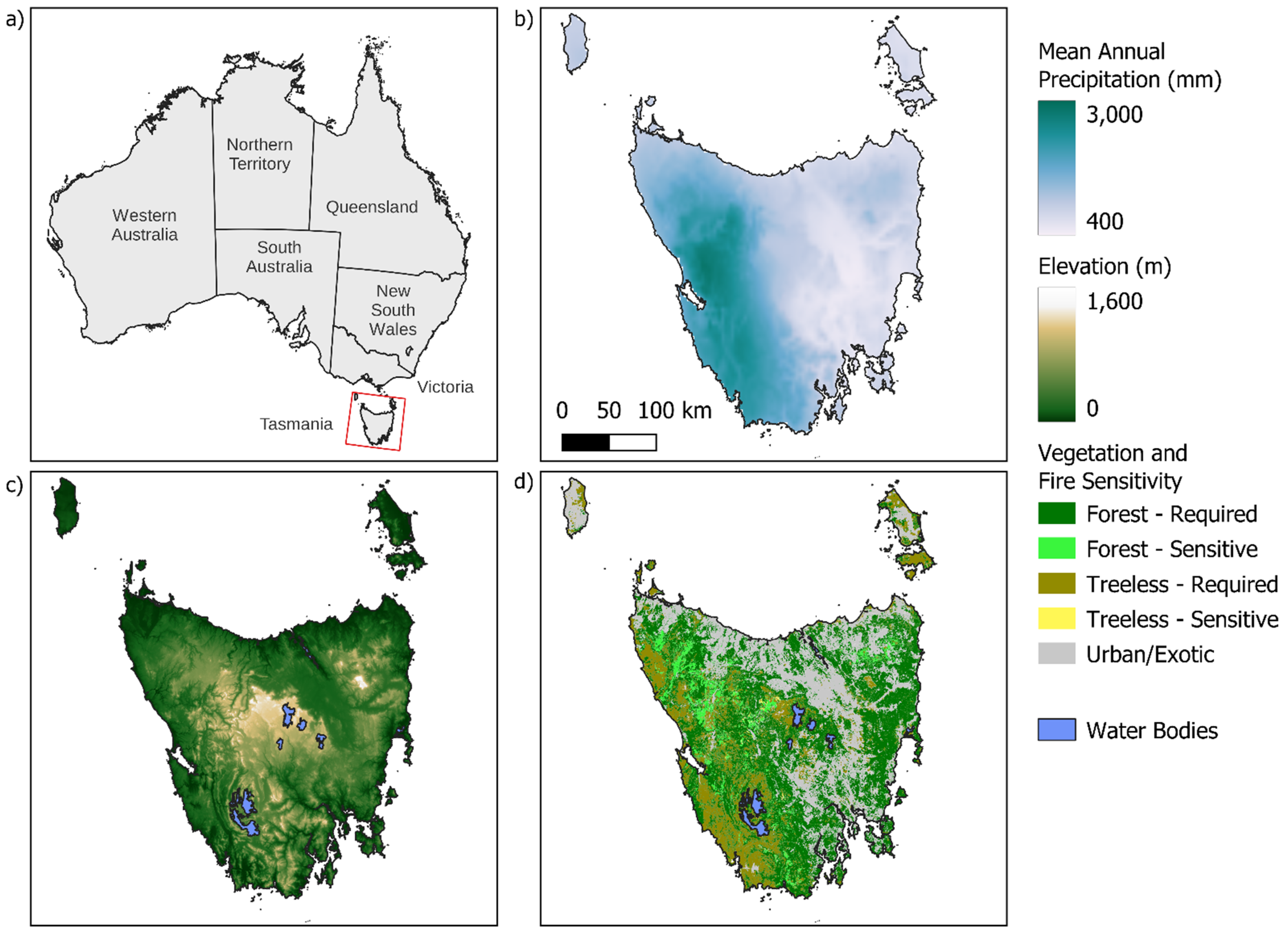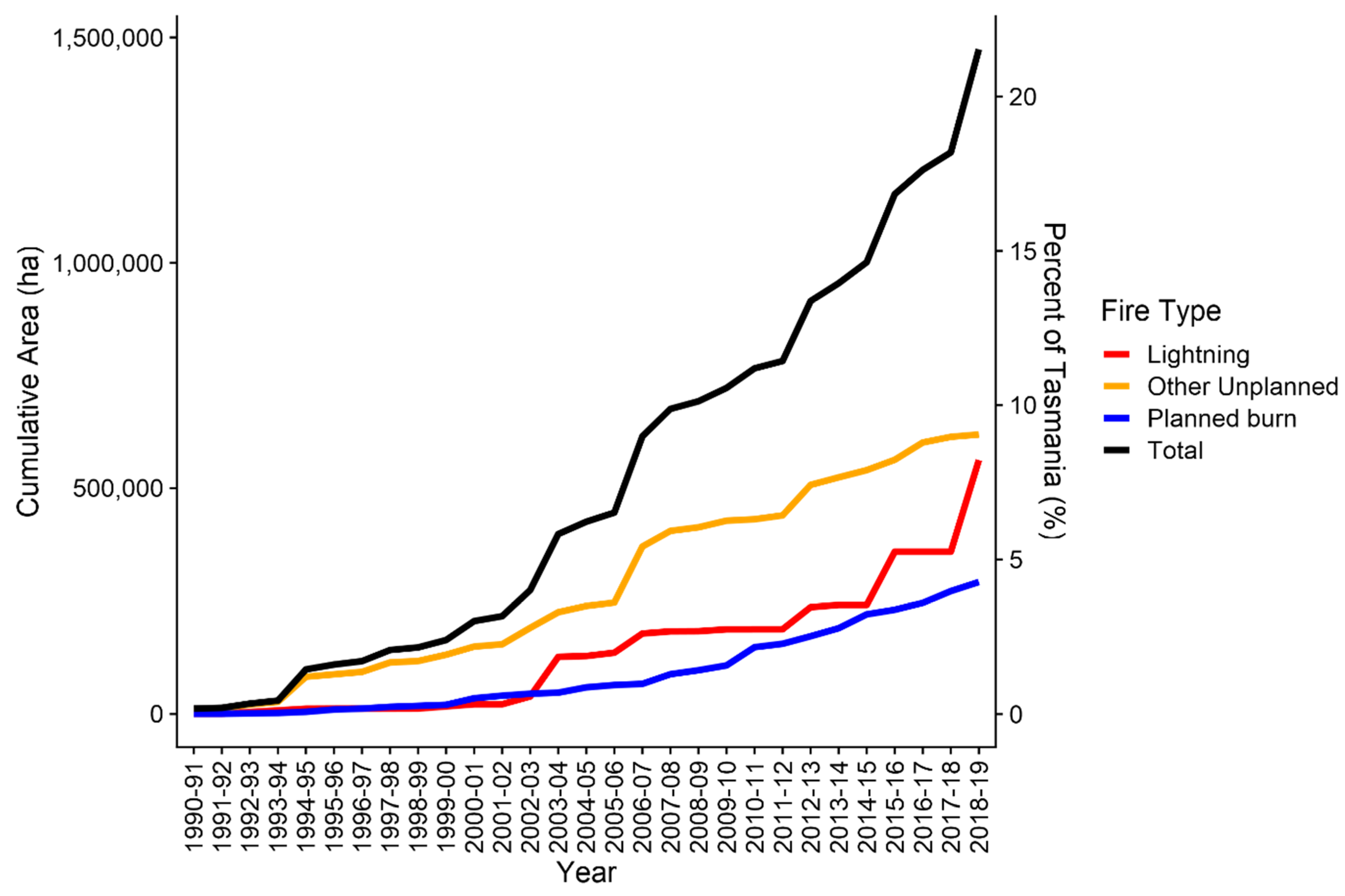Bushfires in Tasmania, Australia: An Introduction
Introduction
- Dedication
Author Contributions
Funding
Conflicts of Interest
References
- Kirkpatrick, J.; Nunez, M. Vegetation-radiation relationships in mountainous terrain: Eucalypt-dominated vegetation in the Risdon Hills, Tasmania. J. Biogeogr. 1980, 7, 197–208. [Google Scholar] [CrossRef]
- Reid, J.B. Vegetation of Tasmania; Australian Biological Resources Study: Melbourne, Australia, 1998. [Google Scholar]
- Crisp, M.D.; Laffan, S.; Linder, H.P.; Monro, A. Endemism in the Australian flora. J. Biogeogr. 2001, 28, 183–198. [Google Scholar] [CrossRef]
- Williams, W.D. Biogeography and Ecology in Tasmania; Springer Science & Business Media: Dordrecht, The Netherlands, 2012; Volume 25. [Google Scholar]
- Bowman, D.M.; Rodriguez-Cubillo, D.; Prior, L.D. The 2016 Tasmanian wilderness fires: Fire regime shifts and climate change in a Gondwanan biogeographic refugium. In Ecosystem Collapse and Climate Change; Springer: Cham, Switzerland, 2021; pp. 133–153. [Google Scholar]
- O’Connell, J.F.; Allen, J.; Williams, M.A.; Williams, A.N.; Turney, C.S.; Spooner, N.A.; Kamminga, J.; Brown, G.; Cooper, A. When did Homo sapiens first reach Southeast Asia and Sahul? Proc. Natl. Acad. Sci. USA 2018, 115, 8482–8490. [Google Scholar] [CrossRef] [Green Version]
- Jones, P.J.; Williamson, G.J.; Bowman, D.M.; Lefroy, E.C. Mapping Tasmania’s cultural landscapes: Using habitat suitability modelling of archaeological sites as a landscape history tool. J. Biogeogr. 2019, 46, 2570–2582. [Google Scholar] [CrossRef]
- Fick, S.E.; Hijmans, R.J. WorldClim 2: New 1-km spatial resolution climate surfaces for global land areas. Int. J. Climatol. 2017, 37, 4302–4315. [Google Scholar] [CrossRef]
- Farr, T.G.; Kobrick, M. Shuttle Radar Topography Mission produces a wealth of data. Eos Trans. Am. Geophys. Union 2000, 81, 583–585. [Google Scholar] [CrossRef]
- Department of Primary Industries Parks Water and Environment. TASVEG—The Digital Vegetation Map of Tasmania. Available online: https://dpipwe.tas.gov.au/conservation/development-planning-conservation-assessment/planning-tools/monitoring-and-mapping-tasmanias-vegetation-(tasveg)/tasveg-the-digital-vegetation-map-of-tasmania (accessed on 17 February 2022).
- Jackson, W.D. Fire, air, water and earth-an elemental ecology of Tasmania. Proc. Ecol. Soc. Aust. USA 1968, 3, 9–16. [Google Scholar]
- Bowman, D.M.J.S.; Wood, S.W. Fire-driven land cover change in Australia and W.D. Jackson’s theory of the fire ecology of southwest Tasmania. In Tropical Fire Ecology: Climate Change, Land Use, and Ecosystem Dynamics; Springer: Berlin/Heidelberg, Germany, 2009; pp. 87–111. [Google Scholar]
- Ndalila, M.N.; Williamson, G.J.; Bowman, D.M. Geographic patterns of fire severity following an extreme eucalyptus forest fire in southern Australia: 2013 Forcett-Dunalley fire. Fire 2018, 1, 40. [Google Scholar] [CrossRef] [Green Version]
- Prior, L.D.; French, B.J.; Storey, K.; Williamson, G.J.; Bowman, D.M. Soil moisture thresholds for combustion of organic soils in western Tasmania. Int. J. Wildland Fire 2020, 29, 637–647. [Google Scholar] [CrossRef]
- Grose, M.; Barnes-Keoghan, I.; Corney, S.; White, C.; Holz, G.; Bennett, J.; Gaynor, S.; Bindoff, N. Climate futures for Tasmania: General Climate Impacts Technical Report; Antarctic Climate & Ecosystems Cooperative Research Centre: Hobart, Tasmania, 2010. [Google Scholar]
- Fox-Hughes, P. A fire danger climatology for Tasmania. Aust. Meteorol. Mag. 2008, 57, 109–120. [Google Scholar]
- Fox-Hughes, P.; Harris, R.; Lee, G.; Grose, M.; Bindoff, N. Future fire danger climatology for Tasmania, Australia, using a dynamically downscaled regional climate model. Int. J. Wildland Fire 2014, 23, 309–321. [Google Scholar] [CrossRef]
- Styger, J.; Marsden-Smedley, J.; Kirkpatrick, J. Changes in lightning fire incidence in the Tasmanian wilderness world heritage area, 1980–2016. Fire 2018, 1, 38. [Google Scholar] [CrossRef] [Green Version]
- French, B.J.; Prior, L.D.; Williamson, G.J.; Bowman, D.M. Cause and effects of a megafire in sedge-heathland in the Tasmanian temperate wilderness. Aust. J. Bot. 2016, 64, 513–525. [Google Scholar] [CrossRef]
- Foulkes, J.A.; Prior, L.D.; Leonard, S.W.J.; Bowman, D.M.J.S. Demographic effects of severe fire in montane shrubland on Tasmania’s Central Plateau. Fire 2021, 4, 32. [Google Scholar] [CrossRef]
- Prior, L.D.; Foyster, S.M.; Furlaud, J.M.; Williamson, G.J.; Bowman, D.M. Using permanent forest plots to evaluate the resilience to fire of Tasmania’s tall wet eucalypt forests. For. Ecol. Manag. 2022, 505, 119922. [Google Scholar] [CrossRef]
- Borchers-Arriagada, N.; Palmer, A.J.; Bowman, D.M.; Williamson, G.J.; Johnston, F.H. Health impacts of ambient biomass smoke in Tasmania, Australia. Int. J. Environ. Res. Public Health 2020, 17, 3264. [Google Scholar] [CrossRef]
- Tasmanian Government. 2013 Tasmanian Bushfires Inquiry Report. Available online: https://www.dpac.tas.gov.au/divisions/osem/2013_tasmanian_bushfires_inquiry_report/2013_tasmanian_bushfires_inquiry_report (accessed on 20 February 2022).
- Press, A.J. Tasmanian Wilderness World Heritage Area Bushfire and Climate Change Research Project. Available online: https://www.dpac.tas.gov.au/__data/assets/pdf_file/0011/313013/TWWHA_Bushfire_and_Climate_Change_Research_Project_December_2016_Executive_Summary.pdf (accessed on 20 February 2022).
- Australian Senate Environment and Communications References Committee. Responses to, and Lessons Learnt from, the January and February 2016 Bushfires in Remote Tasmanian Wilderness. Available online: https://www.aph.gov.au/Parliamentary_Business/Committees/Senate/Environment_and_Communications/TasmanianBushfires45/Report (accessed on 20 February 2022).
- Australasian Fire and Emergency Service Authorities Council. AFAC Independent Operational Review: A Review of the Management of the Tasmanian Fires of December 2018–March 2019. Available online: https://www.fire.tas.gov.au/userfiles/AFAC/AFAC_Review.pdf (accessed on 20 February 2022).
- Adeleye, M.A.; Haberle, S.G.; Connor, S.E.; Stevenson, J.; Bowman, D.M.J.S. Indigenous Fire-Managed Landscapes in Southeast Australia during the Holocene—New Insights from the Furneaux Group Islands, Bass Strait. Fire 2021, 4, 17. [Google Scholar] [CrossRef]
- Wardlaw, T. Measuring a fire. The Story of the January 2019 fire told from measurements at the Warra Supersite, Tasmania. Fire 2021, 4, 15. [Google Scholar] [CrossRef]
- Nampak, H.; Love, P.; Fox-Hughes, P.; Watson, C.; Aryal, J.; Harris, R.M.B. Characterizing spatial and temporal variability of lightning activity associated with wildfire over Tasmania, Australia. Fire 2021, 4, 10. [Google Scholar] [CrossRef]
- Hillman, S.; Hally, B.; Wallace, L.; Turner, D.; Lucieer, A.; Reinke, K.; Jones, S. High-resolution estimates of fire severity—An evaluation of UAS image and LiDAR mapping approaches on a sedgeland forest boundary in Tasmania, Australia. Fire 2021, 4, 14. [Google Scholar] [CrossRef]
- Bowman, D.M.; Williamson, G.J. River Flows Are a Reliable Index of Forest Fire Risk in the Temperate Tasmanian Wilderness World Heritage Area, Australia. Fire 2021, 4, 22. [Google Scholar] [CrossRef]
- Lucas, J.; Harris, R.M.B. Changing climate suitability for dominant Eucalyptus species may affect future fuel loads and flammability in Tasmania. Fire 2021, 4, 1. [Google Scholar] [CrossRef]


Publisher’s Note: MDPI stays neutral with regard to jurisdictional claims in published maps and institutional affiliations. |
© 2022 by the authors. Licensee MDPI, Basel, Switzerland. This article is an open access article distributed under the terms and conditions of the Creative Commons Attribution (CC BY) license (https://creativecommons.org/licenses/by/4.0/).
Share and Cite
Bowman, D.M.J.S.; Kolden, C.A.; Williamson, G.J. Bushfires in Tasmania, Australia: An Introduction. Fire 2022, 5, 33. https://doi.org/10.3390/fire5020033
Bowman DMJS, Kolden CA, Williamson GJ. Bushfires in Tasmania, Australia: An Introduction. Fire. 2022; 5(2):33. https://doi.org/10.3390/fire5020033
Chicago/Turabian StyleBowman, David M. J. S., Crystal A. Kolden, and Grant J. Williamson. 2022. "Bushfires in Tasmania, Australia: An Introduction" Fire 5, no. 2: 33. https://doi.org/10.3390/fire5020033
APA StyleBowman, D. M. J. S., Kolden, C. A., & Williamson, G. J. (2022). Bushfires in Tasmania, Australia: An Introduction. Fire, 5(2), 33. https://doi.org/10.3390/fire5020033





